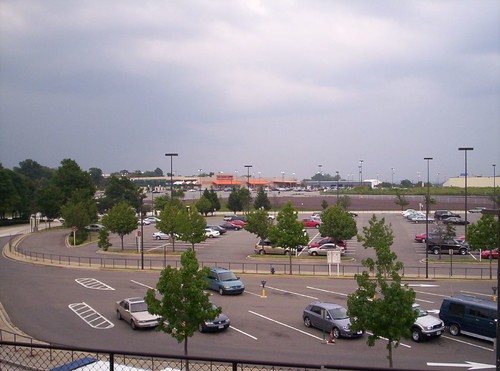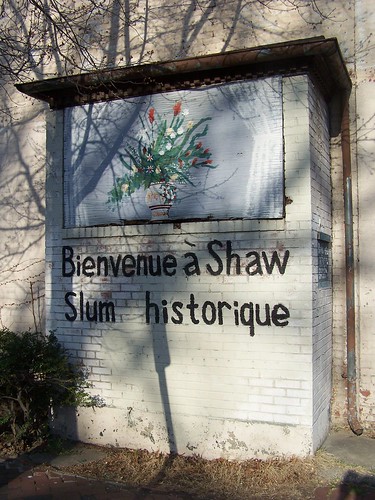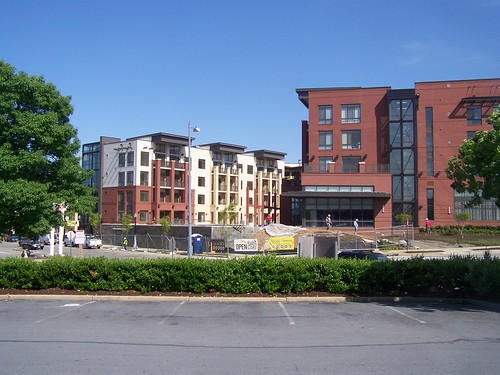Too early to say what the special election in Ward 5 means: but change is coming regardless

Today's Post has an op-ed, "Putting the 'divided DC' meme to rest," by David Alpert, the publisher of Greater Greater Washington, on how the Ward 5 special election result, the election of 35-year old Kenyan McDuffie, is the harbinger of a reduction in the so-called racial divide in the city.
I think it's way too soon to make that kind of declaration, especially considering how the successful 2006 primary victories by Adrian Fenty for mayor, and Harry Thomas Jr. for Ward 5 Councilmember, were seen as a positive step--the harbinger of change, youth, andthe triumph of people born in the city achieving amongst the highest political positions in the city.
We know how that worked out.
While many quarters of the city (continue to wrongly) lionize Adrian Fenty as an agent of change, I think the reality is that his policies accelerated the destruction of many parts of the city's school system, and many of the administration's accomplishments were born out of developments and programs initiated by the previous mayor. And Fenty got a pass on serious contract steering to his friends and the peopling of boards and commissions with his training buddies. And Harry Thomas Jr. is soon to embark on a 38-month sentence in federal prison for conversion of public funds.
-- Primary election special: losing sight of what matters
-- The "system" vs. "Anybody but Fenty"
-- Thinking about the "uncivil war"
I think it's way too soon to draw conclusions from the election results, especially as there was no exit polling. My 2010 fears about voting for Vince Gray turned out to have been right on the money. But the fact that election was called because Harry Thomas Junior resigned after having plead guilty to breaking the law while in office makes the willingness to elect someone new atypical of how people have tended to vote in ward elections.
Judging by the comments of the candidates as printed in newspaper articles leading up to the W5 special election last Tuesday, it seemed as if Kenyan McDuffie was trying to disavow to some extent, "progressivism", as it was seen as a code word for "white" or at least political interests "different" from those typically expressed by longer term residents. And it's not like his land use and transportation agenda, at least before the election, reflected particularly "progressive" viewpoints.

This reminds me of my early experiences as an activist in the H Street neighborhood. Compromise was expected to be one way--you were expected to give in, to capitulate--not unlike how Marshall Brown, father of City Council Chair Kwame Brown, was quoted on the subject a couple years ago:
The longtime white population, the people who got involved in statehood, civil rights and environmental causes, thought of this as a black city,” Brown told Fisher. “But the new white voters aren’t involved like that. They want doggie parks and bike lanes. The result is a lot of tension. ... The new people believe more in their dogs than they do in people. They go into their little cafes, go out and throw their snowballs. This is not the District I knew. There’s no relationship with the black community; they don’t connect at church, they don’t go to the same cafes, they don’t volunteer in the neighborhood school, and a lot of longtime black residents feel threatened.” (from the Post)
That's pretty facile. You can want an improvement in the city and neighborhoods without going to church. But there are issues and as I joke with Anwar Saleem, director of the H Street Main Street program, "revitalization is really hard to do in hetereogeneous communities." Because generating consensus is really difficult.
On the other hand, Bob King, the W5 stalwart known for his connections to the senior constituency, a reliable source of votesfor typically "traditional candidates, and seen as a reliable member of the ward's traditional political machine--at least one faction of it, since the now cleaved off John Ray faction (John Ray, a former city councilmember, is now a leading lobbyist for various real estate and other interests) supported Wilds--supported
Thus far, compared to wards 1, 2, 3, 4, and 6, demographic change lags in W5.
E.g., in W4 from 1990 to 2010 the percentage of African American residents dropped by 20 points. There was a 10 point drop in W5 over the same period.
So it makes sense that legacy political behavior and the longevity of traditional machine politics will be more resilient in W5 until a critical mass of citizens demanding second order change is reached.
The comparatively static nature of DC's black population in demographic terms is discussed in an old paper, "Demographic Dynamism and Metropolitan Change: Comparing Los Angeles, New York, Chicago, and Washington, DC," from Housing Policy Debate. The somewhat inert Chocolate City population gives resilience and instransigence to "old school" political attitudes and agendas.
The op-ed does provide an impetus to consider the future of W5 over the next 10-20 years. So far, with the exception of more traditional suburban development at Fort Lincoln and the development of a big box shopping center adjacent to the Rhode Island Metro, there hasn't been significant new development in the Ward.

This suburban style shopping center at Brentwood was seen by Vincent Orange as one of his major accomplishments. The center's urban design could have been used to strengthen and extend urbanism, instead it focused on automobility, delaying significant economic improvement in the area. The parking lot in the foreground, abutting the Rhode Island Metro station, is now home to apartments, the construction of which is pictured below.
But that's deceptive.
I think Ward 5 is on the cusp of its own transformation, a significant and quantum transformation, not unlike the point where DC was on the eve of 21st Century, two years into the ascension of Anthony Williams as Mayor, and to some extent, the sidelining of Marion Barry as a significant force in the city.
In the late 1990s, after Anthony Williams was elected mayor, advocates had no conception of the depth and breadth and velocity of the change that was about to be unleashed, as the city exited its period of practical bankruptcy, developers felt much more comfortable about investing in the city, and the willingness of people choosing to live in the city instead of the suburbs--opposite of the dominant residential trend since the end of Ward War II--reached critical mass (assisted a bit by a special federal residential tax credit for new residents).
It's hard for people relatively new to the city to understand what it was like in the 1980s or 1990s or even until 2005. We didn't think many neighborhoods, including H Street, Shaw and others, were likely to improve any time soon, or even in our lifetimes. Sadly we didn't have the right planning and policy tools in place to assist us with managing the change that was about to occur.

This graffiti had been painted on a building on 9th Street NW in the Shaw neighborhood, and had been up for years. This photo is from 2006. Today that area is undergoing significant transformation, which was unimaginable just a few years ago.
W5 is about to experience a great deal of mostly residential development, which will result in the influx of thousands of new residents to the ward. The ward will be transformed in the process, in ways that current residents aren't likely to be fully considering. But it's the same kind of change that is has been transforming wards 1, 2, and 6 for the last two decades.
Just like the addition of housing to downtown is transforming ward 2, and to downtown, H Street, NOMA, and the Southeast Waterfront in Ward 6, and the intensification of land use around the Columbia Heights Metro Station is transforming ward 1, Ward 5 will undergo significant changes.
Ward 5 residents, advocates, and community groups need to prepare for the changes, changes that the city was not able to deal with very well in the last decade because we didn't have an:
- adequate housing policy and plan (although the city did a good job for a time improving the DC Housing Authority, doing a lot of HopeVI residential projects--but at the loss of housing units for the extremely impoverished, and the creation of the housing production trust fund to support the development of affordable housing)
- no parks and recreation master plan
- no system for developing true neighborhood plans (we still don't do comprehensive neighborhood planning)
- a zoning code that preferences suburban style development
- community organizations more familiar and comfortable with dealing with a shrinking, declining city rather than knowing what approaches to use to address changes and opportunities in a city that after many decades of loss, was starting to add population
- and a somewhat outdated "comprehensive plan" (even the new one, approved in 2006, has many gaps.)

Atlas Flats development, Bladensburg Road.
Development is moving to Ward 5 because the choicest locations in the northwest quadrant and in Ward 6 are getting built out.
The number of people likely to be attracted to living adjacent to transit is not only increasing significantly, but what matters most is the people attracted to this type of housing tend to be different demographically--younger, whiter, more highly educated, likely with better income potential--than many current residents, especially those that have been living in the ward the longest.
This will be the source of contestation for many years going forward--i.e., the point made above about the difficulty of dealing with change in hetereogeneous communities is fully relevant and apt.
Hopefully, Kenyan McDuffie has it within himself to lead "third order" change, and build the capacity of the citizens, community organizations, and civil society more generally so that residents are empowered and shape the vision and agenda. That's a tall order for any politician. Thus far, no elected official in the city meets such a high bar--most are focused on "helping" citizens to the extent that they remain dependent on the elected official, which aids re-election.
In particular, the Rhode Island, Brookland, and Fort Totten Metro stations (the latter served both by the Green and Red lines) are beginning to see significant new transit-oriented development. (The New York Avenue station is in Ward 6, just south of Ward 5, but the bulk of its impact thus far has been on development in Ward 6.)

The amount of new development that is or will be occurring in Ward 5 areas that are well served by transit will be considerable:
- Bloomingdale and Eckington, mostly the rehabilitation of extant housing and residential turnover, along with scattered infill new development
- housing development at Rhode Island Metro (with housing sites available further up Rhode Island Avenue, the eventual redevelopment of the declining shopping center located at 4th and Rhode Island Avenue, and the conversion into condominiums of many apartment buildings in the area)
- new development at Brookland, currently the "Monroe Market" development and eventually projects on the Subway station site and across the street from it, along with the "Chancellor Row" rowhouse development by EYA on a deaccessioned portion of the St. Paul's College campus
- redevelopment coming to both the W4 and W5 parts of Fort Totten
- the streetcar on H Street will also drive change in the portions of W5 that will have access to it (Trinidad especially) but is also being felt in the development of the now named "Atlas Flats" on the site of the old Sears Department store, which will be a one block walk from a streetcar stop at Bladensburg Road and H Street/Benning Road
- housing being constructed in the Ward 5 side of the "NoMA" district
- and the eventual residential development coming to the now re-termed Union Market. (The developer's video on the future of the development references images heavily drawn from NYC's Meatpacking district);
(There is also the New Communities program, a local HopeVI type program, targeting the area between K Street and New York Avenue, from North Capitol Street to I-395.)
It's surprising to think, but Ward 5, one of the most reliably "black" wards located north of the Southeast waterfront of the city which separates Wards 7 and 8 from the rest of the city, is likely to become majority non-African-American, within maybe 15 years, because of the one-two of influx of new residents to newly built housing, and outmigration and aging out of current residents.

Rustik Tavern, Bloomingdale--five years ago, that a restaurant in this location would be successful and a neighborhood draw was almost inconceivable. The cafe across the street had been robbed a number of times, and the commercial buildings were mostly mouldering.



0 Comments:
Post a Comment
<< Home